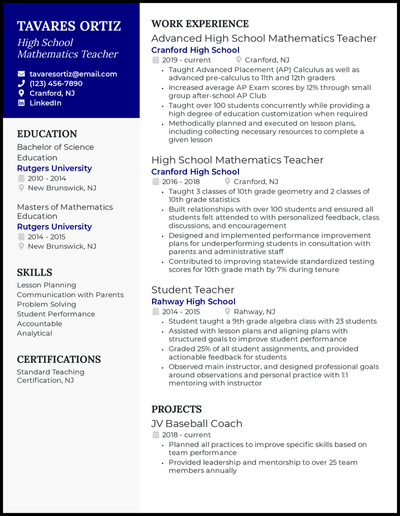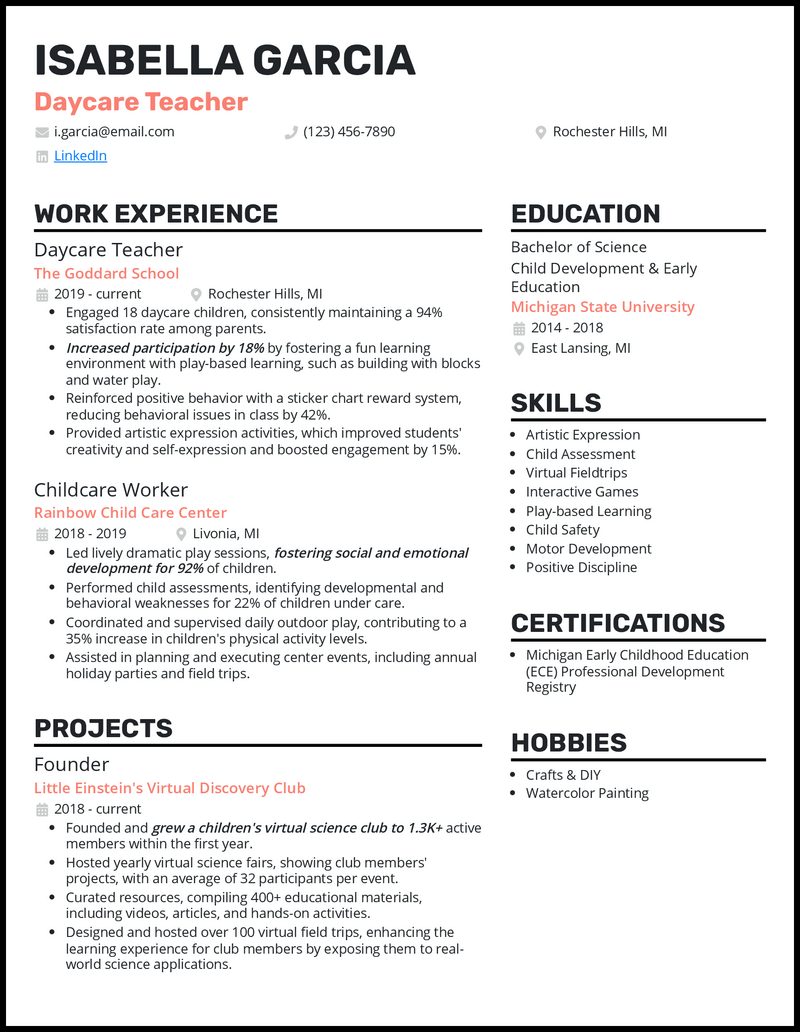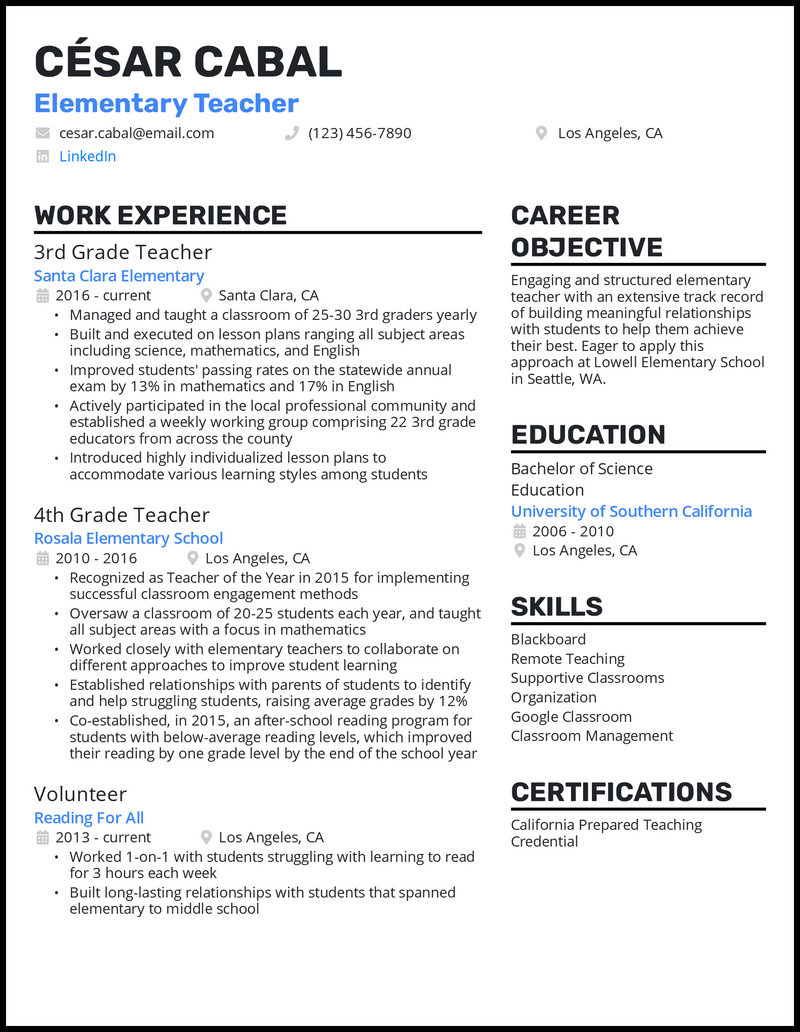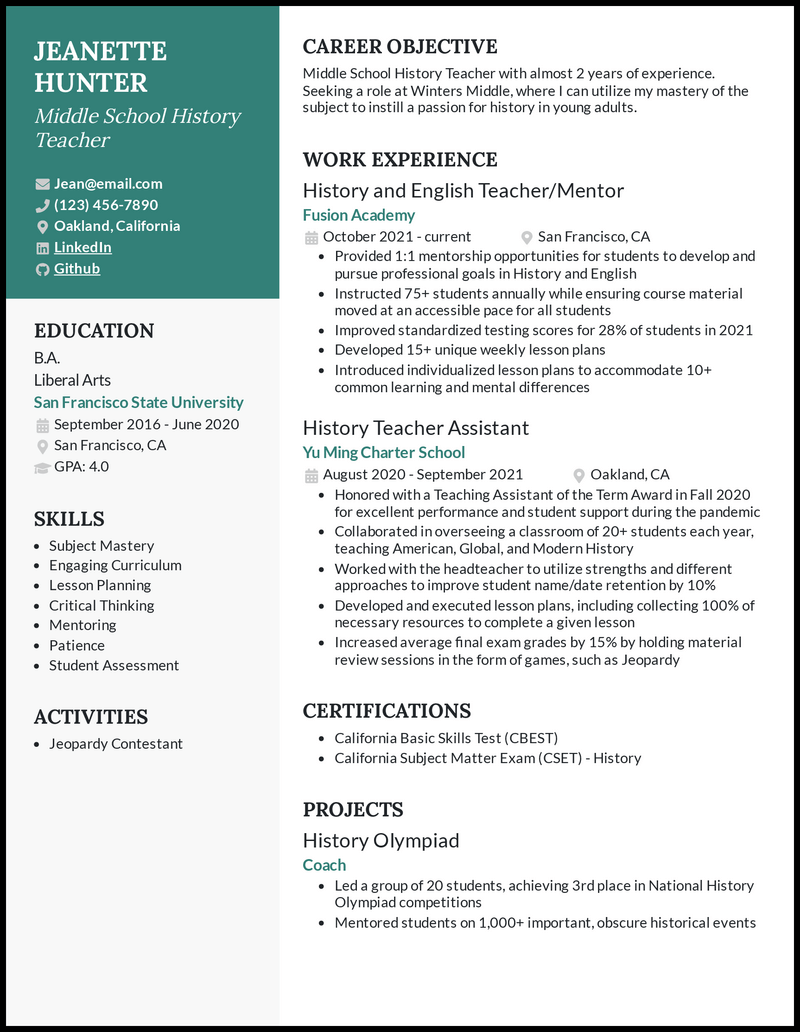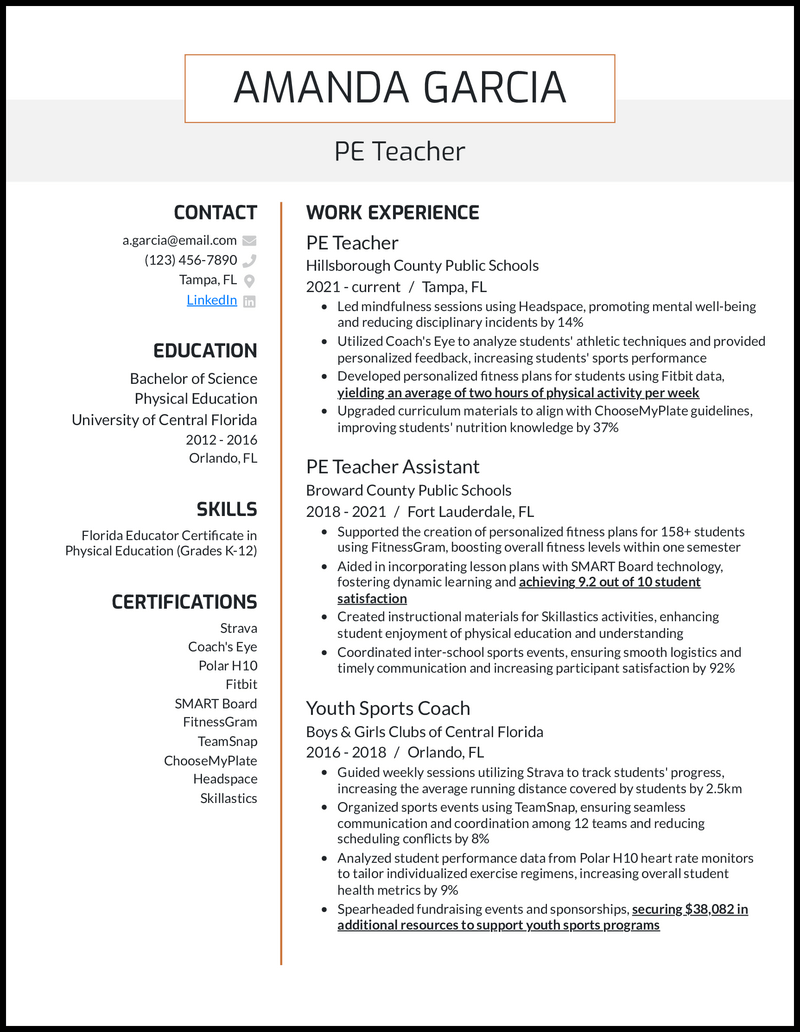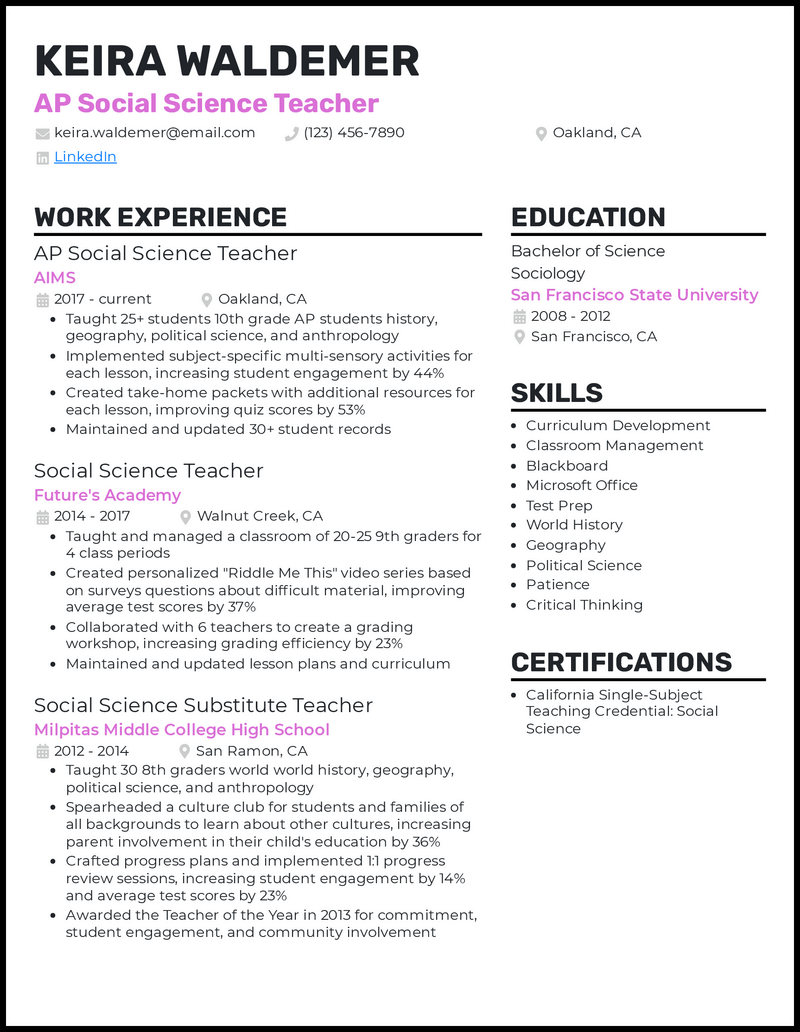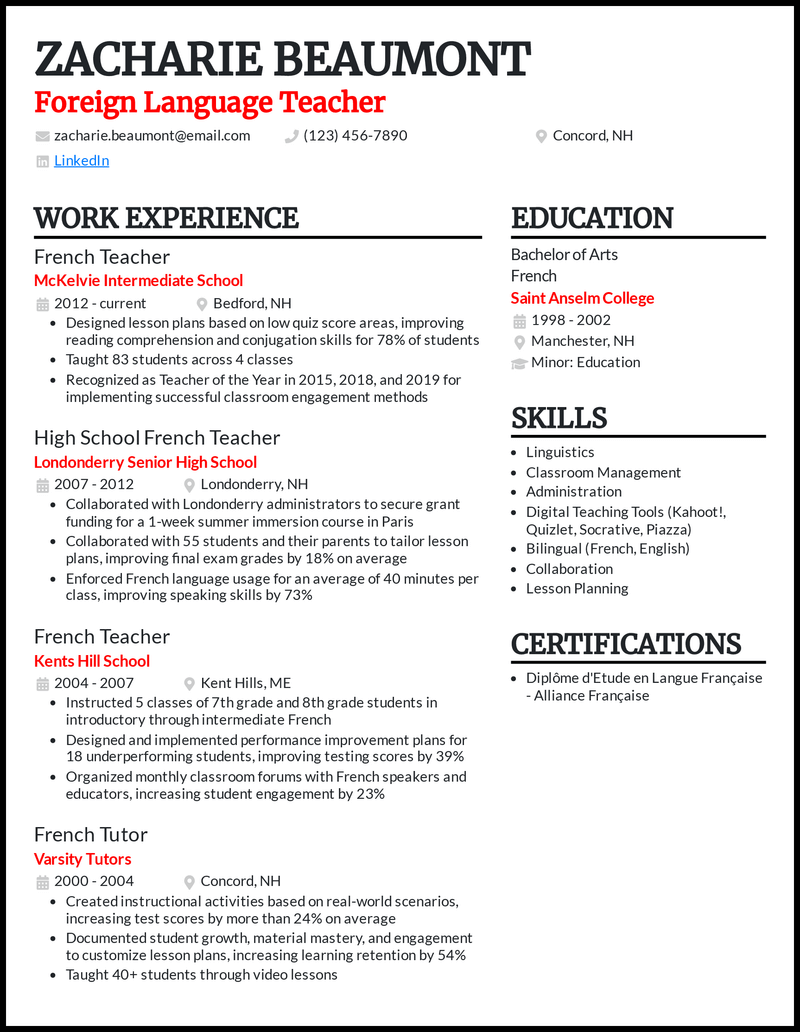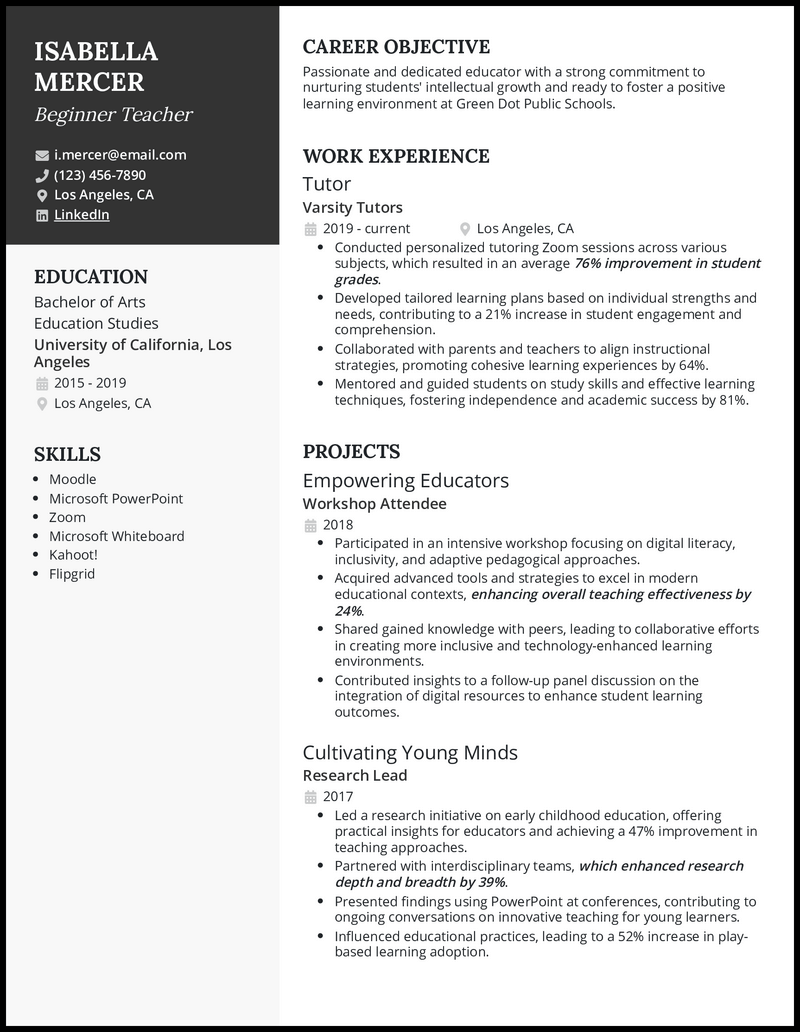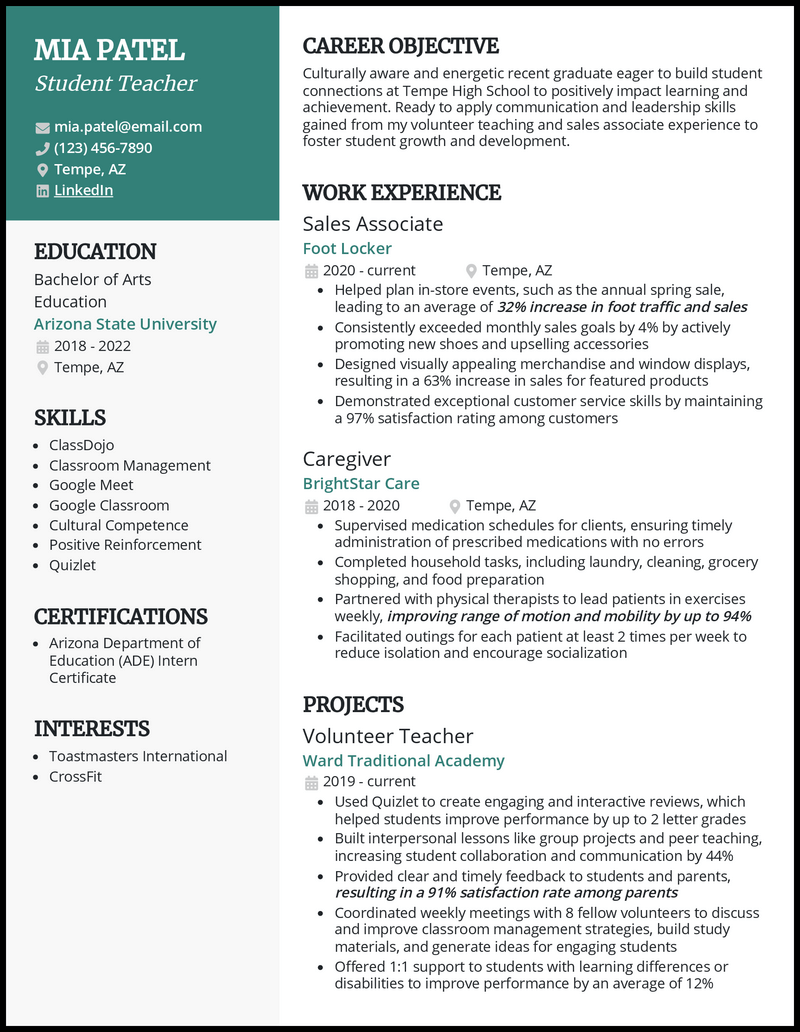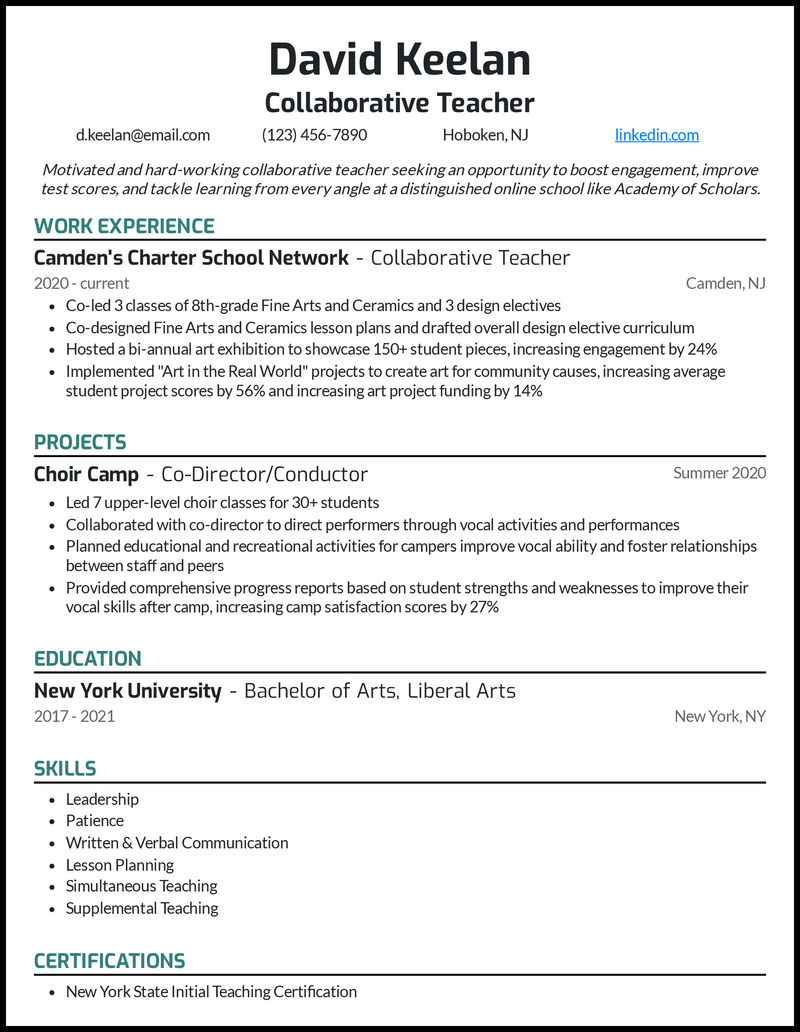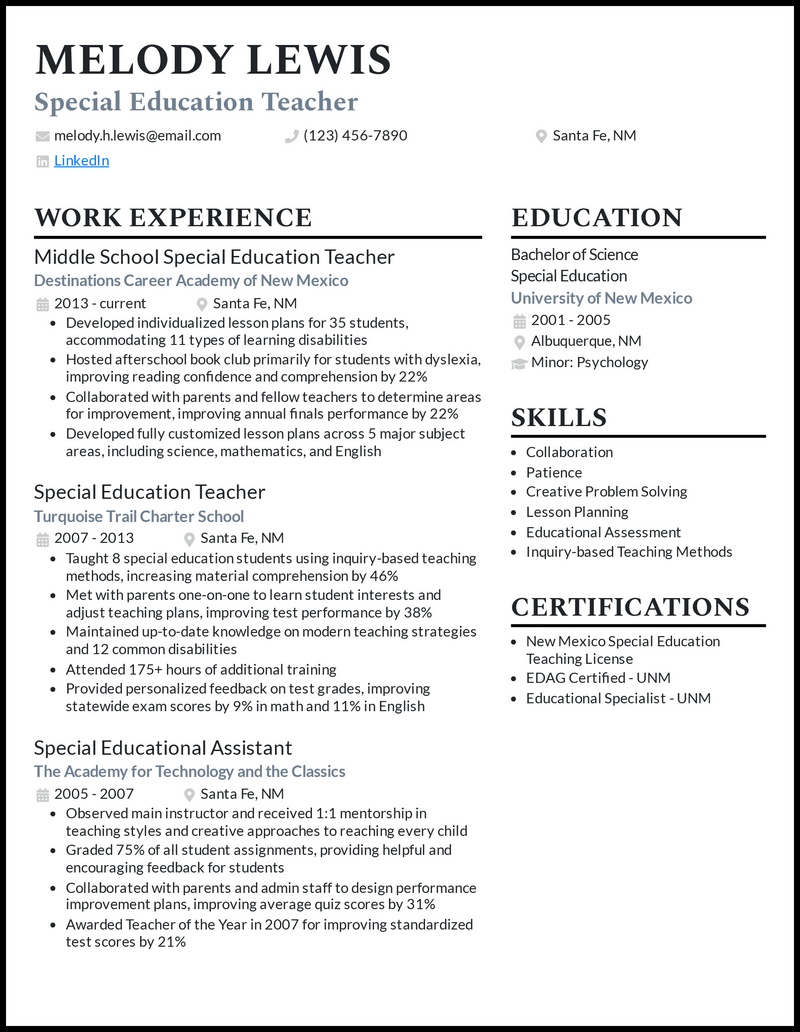Teachers are the backbone of society. You spend more time with the children you educate than their parents do! And effective teachers like you are compassionate, intelligent, and organized, among hundreds of other things.
It can be difficult to highlight all your experience and skills on your teacher resume, and you’ll want to save some for your teacher cover letter.
These 30 teacher resume examples are helping teachers with varying levels and types of expertise land jobs in 2025. They’re a great place for you to get started building or updating your resume.
Please note that this guide is geared toward educators in the K-12 space. If you’re applying to teach at the college level, you’ll likely need to write a CV.
Why this resume works
- Most teachers have some form of student teaching experience during their education, which you can totally include on your teacher resume!
- When listing your student teaching experience, focus on what you contributed instead of your responsibilities.
- Administrators reviewing your resume want to quickly understand the types of classes and grade levels you’ve taught.
- Since you want to make the resume reviewer’s job as pleasant as possible, clearly state the subject and grades you taught in a resume bullet.
- When you go to make a cover letter, this is your ticket to dive deeper into how you helped your students achieve greater success in the classroom.
Why this resume works
- Teaching littles is no small undertaking, so focus your daycare teacher resume around the skills the specific school is looking for—and the skills that set you apart.
- If you’re a pro at integrating play-based learning like building blocks or water play into your daycare environment, do more than list it in your skills section. Use your work experience to show your skills in action.
Why this resume works
- Teaching kids aged 6-7 is never an easy task. They don’t understand things the way grown-ups do. So, listing skills like Canvas LMS may not be the best option.
- Rather, fill your first grade teacher resume with software like ABCmouse, ClassDojo, and Kahoot! Show potential employers that you’re an expert at dealing with little ones and know exactly what technology to use to develop their test scores and talents.
Why this resume works
- Hiring managers have no love for average Joes. Trust us, they won’t even think about touching you with the renowned 10-foot pole if you give them the impression that you’re in that lot. Our advice? Stand out by showcasing relevant certifications in your 2nd grade teacher resume.
- For instance, Tavian throws a certification section in their showpiece to tell the potential employer they’re a certified educator in their state. That not only sets them apart from the stack but also says they’re a safe pair of hands.
Why this resume works
- Yes, 250+ other applicants want that 4th-grade teacher position, too, so it’s really a coin toss whether you’ll bag it. How about adding metrics to your resume to showcase your outcome-oriented mindset and boost your chances of scoring an interview, at the very least?
- Adding phrases like “Cataloged class materials and assignments through Canvas, ensuring smooth operations for a class of 47 students” and “Organized and tracked daily activities and schedules using Padlet, improving routine consistency by 31%” to your 4th grade teacher resume is more like it.
Why this resume works
- Employers first check whether elementary school teacher applicants are licensed to teach.
- Include licenses or certifications in a dedicated “Certifications” section on your elementary teacher resume. Our user-friendly resume templates and Google docs resume templates let you add a section just for certificates and licenses.
- When possible, quantify your impact in your previous roles as an elementary teacher, such as improvements in standardized test scores, reading comprehension, or even classroom participation. These can be rough estimates.
- For example, “Improved students’ passing rates on the statewide annual exam by 13%” effectively shows competency through an estimate.
Why this resume works
- Your middle school teacher resume may include the following sections: Career Objective, Certifications, Projects, and Activities.
- Including a career objective can help explain why you’re a strong candidate if you have limited work experience or if you’re undergoing a career change.
- Certifications are typically required qualifications for teachers, so it’s best to list any relevant certificates you’ve acquired.
- Projects can be a great place to highlight experiences not technically work-related but still highly relevant to your passion for teaching.
- An activities section is the spot for interesting, quirky experiences or hobbies on your resume; just be sure you can explain why they’re relevant when you get an interview!
Why this resume works
- Are you the kind of person who lights up when you see a roomful of kids eager to soak up knowledge? Now is your moment to shine, even if the butterflies in your stomach beg to differ regarding your limited professional experience. A tailored career objective could be the game changer for your first year teacher resume.
- Succinct, to-the-point, and intriguing are everything your career objective should be-it should be two to three sentences summarizing your teaching career goals and demonstrating your readiness to help the hiring institution attain its objectives. Weaving in mentions of past relevant experiences like a teaching internship can leave a solid impression that gets you hired.
Why this resume works
- The “Education” section of your high school teacher resume should list the degree you’ve earned. No need to list high school since that’s a given.
- Focus your resume on achievements instead of responsibilities.
- For example, instead of saying, “Prepared students for standardized exams,” say, “Helped improve standardized testing performance by 3%.”
- For each of the skills you put on your resume, you should be able to show an example of when you demonstrated that skill in practice.
- If you list “collaboration” as a skill, then somewhere in your resume’s work experience bullet points, it should be clear that collaboration is part of your repertoire.
Why this resume works
- How does keeping several balls in the air, from catering to kids’ needs to meeting parents’ expectations, sound to you? Like your cup of tea, right? Well, why not let recruiters know you’re in it for the long haul by flaunting industry-relevant credentials in your kindergarten teacher resume?
- Just below your list of skills, drop in a succinct certifications section showing off credentials like Certified Child Life Specialist, Early Childhood Education Specialist, or Child Development Associate (CDA. Besides validating your seemingly vast industry knowledge, these elevate you from the crowd of folks who’ve got the experience but might be missing those credentials.
Why this resume works
- Guiding special needs children through life’s big changes is where you truly shine—you’re one of a kind. The recruiter wants you to show them how good you are, though, which is your cue to spotlight your wins in similar roles.
- Let phrases like “Designed a new life skills curriculum supported by zSpace’s virtual simulations, increasing student competency in daily tasks by 38%” and “Utilized Kurzweil 3000 to provide reading support for 18 students, improving comprehension and retention of transition materials” take center stage in the work history of your transitioning teacher resume.
Why this resume works
- You already tick all the necessary checkboxes for a PE teacher’s hands-on experience, a remarkable blend of soft and hard skills, and possibly several industry-recognized certifications. However, without evidence of role-specific education, your otherwise superb PE teacher resume could still fall short.
- Save a small section on your resume’s side column for role-relevant tertiary educational background, much like how Amanda flaunts her bachelor’s degree (Physical Education) from the University of Central Florida. It’s about showing you’ve put a great deal of work into amassing the necessary knowledge and skills.
Why this resume works
- Apart from including key achievements like improving students’ vocabulary and pronunciation, make sure you add relevant educational qualifications and/or certifications.
- Having a degree like a Bachelor of Arts in Spanish and Portuguese or a certificate like “Single Subject Teaching Credential in Spanish” in your Spanish teacher resume are great ways to prove your professionalism in teaching foreign languages. ¡Feliz búsqueda de empleo!
Why this resume works
- Do you pride yourself on being a mini Albert Einstein and relish every moment you spend with your lab coat on? Great, but is your science teacher resume polished enough to get recruiters sold on your brilliance?
- You see, few other things piss off hiring managers as much as a resume littered with grammatical mistakes, from typos, punctuation errors to awkward phrases. And that brings us to the essence of staking the time to meticulously proofreading yours before hitting the send button. Better yet, involve a second pair of eyes, be it a friend, family member or career coach.
Why this resume works
- Beyond teaching, what other value did you add to your students to support their pursuit for knowledge and their future success? Like Yuki, did you help students prepare for scholarship interviews, and they emerged victorious?
- Such unique achievements make your math teacher resume shine and grab the attention of your dream employer. Identify such feats in your career and let them take center stage in your application.
Why this resume works
- Are you passionate, dedicated and known for fostering creativity and artistic growth in students? Great! Your art teacher resume should stand out by showcasing proficiency in utilizing a wide range of artistic tools and technologies to engage learners and encourage artistic exploration.
- Your also have to prove that you go beyond the curriculum to offer students more opportunities such as through showcasing their work to the world.
Why this resume works
- Remember to proofread your social science teacher resume. One of the main reasons school admins reject candidates is poor grammar because it shows a lack of attention to detail; teachers of all professionals really need an A+ resume!
- Ask a friend, colleague, or even a co-worker to proofread your resume. If you’re low on time, invest in a spell-check system like Grammarly or run your resume through our resume checker to catch any typos or comma errors.
- Keep your resume focused by using sections and subheadings throughout. Essential components like your contact information, work experience, education, skills, and certifications/licenses are the bread and butter of your resume.
- All our example resumes include the essential sections, and you can add your own sections to customize your template to your specific needs.
Why this resume works
- Your AP English teacher resume can include a summary statement if you’re a veteran in the industry.
- Summaries are two to three-sentence paragraphs that can be thought of as a recap of your best self on your resume.
- Purely optional, you can include one if you have years (10+) of experience in your field.
- Summaries work best to showcase your tried and tested years in the education field and any specializations you’ve honed, such as teaching AP-level courses.
Why this resume works
- Make your foreign language teacher resume stand out with the right keywords in your resume skills section.
- Why? Hard skills are more specific to your profession and easier to demonstrate throughout your resume. Plus, they show school admin that you’ve already got some technical know-how for the job.
- Aim to include six to eight specific skills, emphasizing hard skills (like “bilingual” and “lesson planning”) over soft skills (like “organization” and “caring”).
- Making a resume for the job description is always a good idea, but how do you do that? Start by customizing your work experience bullet points for the job you want.
- If you’re hoping to switch from teaching German to teaching history, you don’t need to include many details on your strategies for teaching verb conjugation, for example.
Why this resume works
- So, do you have what it takes to mold the next Daniil Trifonov? Let the hiring manager know that well-kept secret by quantifying outcomes in your piano teacher resume.
- Throwing in metrics like “Utilized Google Classroom to share updates and progress reports, garnering a 9.3/10 average rating from families” is a potent trick to get in the recruiter’s good graces. It doesn’t just shine a spotlight on your fortes (including a goal-oriented mindset) and gives you an edge over the competition.
Why this resume works
- Your teaching moments happen beyond the regular school day, but you still get the job done. An after school teacher resume that showcases your technical expertise can prove that you’re on the ball when it comes to instilling knowledge in them and nudge one step closer to landing an interview.
- Don’t just curate a laundry list of your technical proficiencies, though. If a handy tool like Google Classroom graces your skills section, illustrate how you leveraged it to improve learning experiences.
Why this resume works
- Your experienced teacher resume must prove you’ve been tested and proven to be a terrific tutor. Anything less that convincing will dim the chances of your application sailing through.
- It’s perfect time to turn to your technology skills and how you’ve tapped them to solve everyday teaching challenges. Show how you’ve leveraged Zoom and Google Classroom for virtual teaching, Quizizz for tailored tests that improved average students score, and so on.
Why this resume works
- Education is a combined effort of different stakeholders, and this is why your new teacher resume should show your role in bringing together different parties such as parents to get involved in their children’s education.
- Also, show how it has been a lifelong process for you, and how you are ready to bring in your set of pedagogical skills in the learning environment.
Why this resume works
- When you lack paid experience in the field, never underestimate the power of projects in your student teacher resume.
- Schools know you have to start somewhere, so what they’re really looking for is that you show the promise and potential to step inside their classrooms and successfully manage and teach a class.
- If you’ve volunteered as a teacher after school, provided tutoring or homework help, or even assisted in a teacher’s grading load, you have valuable experience to add to your resume.
Why this resume works
- Your teacher assistant resume should discuss specific contributions.
- Instead of vaguely stating, “Worked with assistants and teachers,” give concrete details, like “Worked with 2 assistants and teacher to provide instruction to 60+ 2nd graders with IEPs.”
- As an entry-level teacher’s assistant, consider using a resume objective.
- An objective is valuable if you’re light on experience and need to fill some white space, but it loses its value if it’s not customized.
- Tailor your objective by mentioning the target school by name and sprinkling in some keywords from the teacher job description, so long as they honestly describe you!
Why this resume works
- If you’re a certified substitute teacher (or teacher) in your state, include that in a dedicated “Certifications” section on your substitute teacher resume. This will help you stand out from other applicants, as this is not required in every state.
- Any prior subbing experience should highlight maintaining a disciplined classroom. One of the toughest aspects of being a sub is commanding a classroom, so demonstrating your strength will increase your chances of getting an interview.
- Another way to impress is by formatting your resume’s work history in reverse-chronological order; it lists your most current and relevant experience first, so the admin can glimpse your best stuff first.
Why this resume works
- Proper resume formatting can help your collaborative teacher resume look aesthetically pleasing, helping set you apart in the sea of generic resumes.
- Choose one or two key areas, such as section titles or your header, to include a pop of conservative color.
- Use two contrasting fonts on your resume template. Just don’t pick anything hard to read—remember, recruiters scan resumes within seconds, so it has to be understood at a glance.
- If you’re short on work experience, you can highlight projects that demonstrate your aptitude as a collaborative teacher.
- Even if your projects aren’t teaching-related, highlight skills you used or developed, like working with kids, collaborating with co-workers, or taking a leadership position.
Why this resume works
- When you’ve finished writing your work experience and are ready to check your resume, look for the following:
- Does your resume take up the entire page?
- Does it have half to one-inch margins? (Either half an inch or one inch is fine.)
- Does your resume include separate sections for contact information, education, skills, and work experience?
- Details can make or break your special education teacher resume, so don’t neglect the little things before you submit it to the world.
- Start each bullet point with action words, like “spearheaded” or “brainstormed.”
- Either end all bullet points with a period or none at all. Be consistent with punctuation.
- Write your work experience in the past tense.
- Avoid using personal pronouns like “me” or “I” on your resume. We’re pretty sure the employer already knows you’re writing about yourself!
Why this resume works
- While your competitors rest on the laurels of their handful of year’s worth of experience, strive to be unique by flaunting industry-recognized credentials and certifications in your assistant teacher resume.
- Consider a certifications section in which you proudly spotlight credential like Child Development Associate (CDA), just as Matthew does. Of course, a proven understanding of early childhood education best practices is sure to get a nod from the hiring manager reading your piece.
Why this resume works
- As unbelievable as it sounds, your future as an education assistant rides on the hiring manager’s quick glance at your teacher aide resume. Make every second count by capitalizing on the reverse-chronological format for your work history.
- Begin by spotlighting your most recent, senior position (paired with key quantified achievements and relevant tool applications) and backtrack through your junior roles. This technique is golden for illustrating your career progression in a resume and should show an increment of responsibilities and wins as you go up.
Related resume guides
Formatting Your Teacher Resume
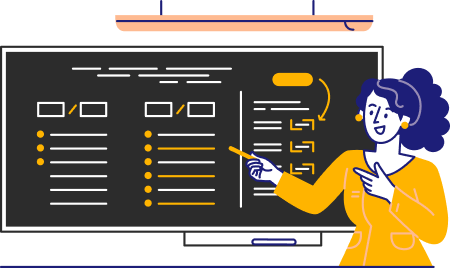
Formatting ensures your teacher resume is readable, logical, and complete. Imagine understanding a book without chapter headings or margins and no discernable organization. It would be a nightmare to parse out any information when nothing follows a clear structure and doesn’t lend itself to being read correctly. It’s an extreme example, but it proves the necessity of formatting.
Just as you create lesson plans to help your class learn best, format your resume so your qualifications are conveyed and understood. We’ll cover three important formatting elements in the following sections: resume formats, your contact header, and resume readability for ATS.

Three resume formats
The most popular resume formats for 2025 are reverse-chronological, functional, and combination/hybrid. Here are some of the pros and cons of each:
- Reverse-chronological: This format highlights your career progression in an easy-to-scan list, making it ideal for recruiters and ATS. However, this format exposes time gaps and can be repetitive if you’ve held the same position at multiple schools.
- Functional: This format focuses on your skills, ideal for limited teaching experience or gaps. However, it’s commonly known to confuse potential employers and ATS.
- Combination/hybrid: This leverages an in-depth skills section and a small experience section to accurately summarize why you’re the best candidate for the job. However, it’s easy to structure this poorly, and it can look like you’re hiding a lack of work experience.
We advise the reverse-chronological format for your teacher resume because it proves you have practical knowledge and a steady career. This format tells the story of your teaching career in under six seconds, which is how long recruiters will take to read your resume.

Include the right details in your contact header
Your contact header should be easy to locate and read. Some suggest not adding contact information in the header, but that’s why formatting your contact header properly is so important. With good formatting, none of your information gets buried, and it can distinguish you from other applicants. You should include:
- Name
- Job title you’re seeking
- Phone number
- City, State (optional)
- Professional links such as your LinkedIn profile (only if relevant)
Per industry standards, place the header in either the top left-hand corner or centered beneath your name. Not enough space? Remove the optional elements or go down a font size. Choose a sans-serif font that’s no smaller than your resume’s body text.
Like the example below, you can put your header in a color block to grab attention quickly and add personality. It’s best not to use obnoxious colors (neon green would be a hard no), and always double-check that the color works well with black body text or white font.
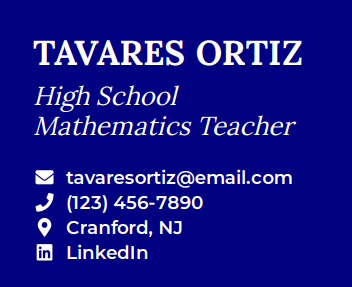
Sometimes, the ATS won’t read your resume properly despite having a beautiful header. That’s why we recommend submitting it as a .docx (friendly for ATS) and as a PDF (friendly for employers).
We have plenty of excellent resume samples you can check out for inspiration on your header, and if you’re rushed, choose one of our free resume templates to start and finish your teacher resume in record time.

Ensure the ATS and employers can read your resume
To ensure your resume reaches principals and department heads, you’ll need to pass muster with the ATS. The good news is formatting for the ATS also results in a resume easy to read by employers.
Resume tips to steer you on the right path:
- One page:
- Not only is a one-page resume faster for recruiters and ATS to scan, but it forces you to be concise and include only what’s relevant.
- File type:
- Most ATS don’t recognize documents in Open Office, Adobe Pages, HTML, or PDF (on occasion). The wisest option is to submit your resume as a .docx and as a PDF to give employers options if one doesn’t work.
- Font sizes:
- The standard 10–12-point font is the best readability range for employers and ATS.
- Fonts:
- Even at a reasonable size, some fonts are hard to read, unprofessional-appearing, and ATS-unfriendly. Stick to standard sans-serif fonts like Helvetica or Arial.
- Margins:
- One-inch margins are standard, but you can be flexible. Avoid going smaller than a half-inch or larger than one inch to keep your teacher resume professional and tidy.
- Header names:
- You may confuse the ATS and the school if you have odd header titles. Use standardized headers, as you see in our resume samples, to make each section easy to find (and comprehend).
- Skills:
- ATS uses keywords to determine your eligibility, including skills (Google Classroom, modifying lessons, parent communication, etc.) matching what’s in the job ad.
- Logical order:
- If your resume sections aren’t in the recommended order, they may confuse ATS. Yet again, it’s best to stick to the standard by using an AI resume generator.
Writing Your Teacher Resume
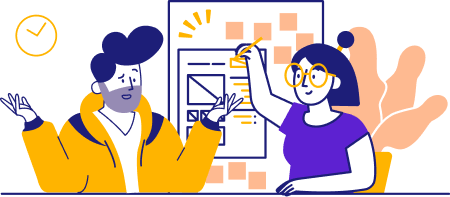
Writing an effective resume may feel daunting, but it’s far more manageable if you take it section by section. You may even want to use one of our fresh Word resume templates designed just for teachers. Let’s dive into each resume section you’ll want to consider:
- Does an objective/summary on your teacher resume matter?
- Teaching history
- Top skills for educators
- Listing education, certification, and optional sections
- Customize your teacher resume for the job
- Revise and edit your teacher resume

Does an objective/summary on your teacher resume matter?
Principals and their hiring teams may see hundreds of resumes across a wide array of teaching roles, so it’s crucial to showcase your talents and personality quickly. Objectives and summaries can work as excellent introductory tools, but many end up being generic, boring, or vague.
First, consider whether you’ll use an objective or summary statement (or neither). An objective highlights your interest and qualifications for the role, while a resume career summary distills your specialized skills and experience in a few lines. Use an objective if you’re seeking your first teaching position or switching from teaching one subject to another. On the other hand, veteran teachers may opt for a summary (or no statement at all).
Regardless of your circumstances, if you use either of these introductory statements, you should always tailor your message to the position. Let’s look at specific examples to contrast a D+ resume objective with one worthy of an A.
A generic, vague objective tells recruiters nothing about you beyond the bare minimum:
New high school teacher seeking employment at a local high school closer to family. Talented at communicating with teenagers and teaching. Received many compliments and letters at last place of employment.
The above objective lacks personality and neglects to mention anything specific. This next objective, however, is focused and tells the principal about the applicant’s skills:
Compassionate algebra tutor with 4+ years of experience. Excellent at coaching students in formulas and helping them develop analytical thinking skills and mathematical competency at all levels of ability. Seeking to use my communication and interpersonal skills to build meaningful student relationships and improve their mathematical abilities at Joaquin High School.
Like the visual example below, the above objective works because it details the applicant’s experience and how it’s relevant to their new goals within the classroom.
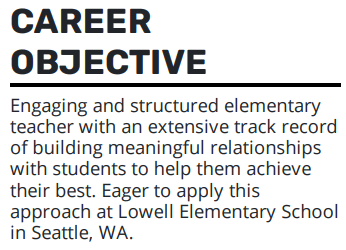
With summaries, it’s difficult to narrow down years of experience into one paragraph, so they often end up looking like this:
Skilled and experienced teacher who loves working with littles. Adept at communication and care. Excited to use my skills for Sunnyside Elementary.
For starters, repeating “skilled” and “experienced” won’t tell employers anything. A good summary should sell your experience and qualifications, making principals wish they’d had the chance to hire you years ago:
Elementary education teacher with 12+ years of experience managing 25-30 1st, 2nd, and 3rd graders’ classrooms. I am a patient, personable, and compassionate professional eager to bring my expertise to Sunnyside Elementary. Awarded Teacher of the Year in 2020 and 2021 for creating online individualized lesson plans for over 65 students during the height of the pandemic.
This summary works because it tells the recruiter their specific qualifications, namely personalized lesson plans and classroom management, and their skills (in this case, two awards).

Teaching history
It’s tempting to list every job you’ve ever had to prove you’re qualified, but this becomes either overwhelming or redundant. It also means you can’t include much about each position, which won’t inspire principals to hire you.
Instead, pick two to four of your most relevant teaching positions. Quantify your responsibilities and incorporate skill keywords to improve your ATS score with each.
No teaching experience yet? Add internships, student teaching, volunteering, or other special projects like the example below that can highlight your soft skills like leadership. Certifications and awards are helpful additions, too.

How to write your job description bullet points
Whether you’re describing a past job, an internship, or a college project, you’ll need to craft your bullet points with care. Every word counts, so use active verbs, definitive language, third-person pronouns, and consistent verb tenses. Pay careful attention to consistency with punctuation—using periods at the end of some bullets while none for others is sloppy.
Based on these resume writing tips, here are some examples of well-crafted bullet points suited for a teacher resume:
- Taught mathematics, English, general science, art, geography, and history to 60+ 3rd grade students
- Collaborated with parents to discuss student performance and options for an improved learning experience, such as individualized instruction for students with learning disabilities
- Hosted annual fundraiser to raise $6,500 for 10+ teachers to attend the RAISE conference and led yearly trips to RAISE meetings, resulting in overall more effective teaching strategies and a renewed passion for academia
These bullet points work because they’re descriptive and results-oriented. Strive for conciseness and specificity with your job description bullet points.
Maximize your classroom impact with numbers
From an employer’s mindset, metrics cement your abilities by proving that your actions resulted in a desirable outcome. If possible, include metrics on 50 percent of your job description bullet points to showcase the results of your effective teaching.
When talking about past teaching roles, it’s a good idea to discuss the following metrics:
- Increase in test scores, passing rates, or grade point averages
- Number of students/classes taught
- Increase in student participation/improved behavior
The following examples use the metric types listed above to describe a teacher’s impact further:
- Co-founded a S.T.E.M. club with the aid of 4 fellow teachers, increasing student passing rates in science and mathematics by 13%
- Established weekly one-on-one student conversation sessions to intentionally build student-teacher relationships, resulting in a 15% overall increase in classroom participation and attendance
- Hosted monthly Write-Til-You-Drop sessions for high school students struggling in English and offered expertise for outlining thesis development and argument structure, which resulted in 31% higher essay scores for participating students

Top skills for educators
The skills section of your resume is a quick guide to what you bring to the table as a teacher. That means choosing the right skills for each job is crucial. You might be organized and great at time management, but if employers want to see that you’re compassionate and great at lesson planning instead, your resume may be set aside.
Since teachers fulfill many roles, employers will want to see a host of varied skills, including soft, hard, and technical capabilities, such as these:
Common teacher skills
- Collaboration
- Problem-solving
- 1:1 communication
- Blackboard
- Organization
- Class management
- Empathy
- Active listening
- Lesson planning
- Google Classroom
- Parent communication
- Gradebook software
These skills demonstrate aptitude and support the responsibilities a teacher must complete on the job. Remember that while the above list outlines common and popular teacher skills for your resume, defer to what the job description is explicitly seeking.

Education, certifications, and optional sections
You’ll need to include different elements on your resume depending on your education level, years in the workforce, and any specializations or concentrations you possess. All teaching positions require a bachelor’s degree, and an increasing number of teachers hold a master’s. Also, ensure you’re up-to-date on your state certifications, like the California candidate below.

If you hold many certifications, you don’t necessarily need to include them all if you’re applying for one specific role. For example, suppose you’re an ESL-certified teacher with a graduate ESL certificate seeking an ESL role. In that case, you’ll need to include that certification either in a summary/objective, in your work experience, or in your education.
This candidate’s education speaks volumes with a classic bold font and color.
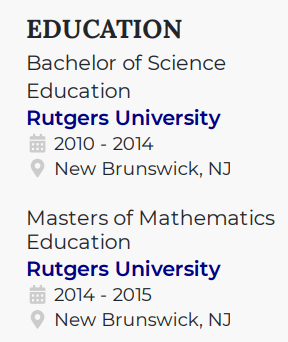
While including education and certifications is required, a projects section is optional. If you’re a drama teacher, for example, new to directing but experienced with leading drama camps, including a projects section to describe the drama camps you’ve led or assisted with can add a relevant impact. List and discuss projects on your resume, just like a paid position.
Additionally, consider adding interests and hobbies to your resume. Most teacher resumes should save room for other information, but it’s a good idea to add these sections when the job you’re applying for stresses the importance of school spirit and culture.
Choose your interests that reflect the school’s values. However, be picky about what you include. Finding every Easter Egg in the entire timeline of Zelda games might be your favorite pastime, but that doesn’t mean you should list it on a resume (unless you’re applying for Nintendo, in which case this might be appropriate, and you’re reading the wrong resume guide).
It’s up to you whether you include any optional sections on your resume, but always be sure to be as specific as possible. Your interests should also be specific. “Reading” doesn’t say much about you, but “leading classic book clubs” is far more likely to get you a job as an English instructor.

Customize your teacher resume for the job
Generic resumes are easy to spot and will likely get tossed. To avoid the trash, tailor your resume to every position you apply for. This tells principals you’ve researched the school and the role, and you genuinely care about the position.
To customize your resume, scan the job ad to know what responsibilities, accomplishments, and keywords to include in your skills section and your bullet points. You should also tailor your objective/summary (if used) to have the school’s name and speak to anything unique about the school that particularly interests you. Check your resume against the job description to ensure you’re addressing their concerns.

Revise and edit your teacher resume
As a teacher, you already know the pitfalls of submitting drafts before they’re revised, so don’t let minor mistakes slip through the cracks. Instead, take a break and hand your resume off for peer review. You can also use our free resume checker to get tips from our AI software.
After a day, return to your resume and consider the constructive criticism you received. Edit and check for errors, inconsistencies, or gaps. Read through your resume at least twice more, one for content and one for proofreading. Once you’re sure it’s error-free, you can submit it proudly.
Start Setting up Your Classroom (Almost)
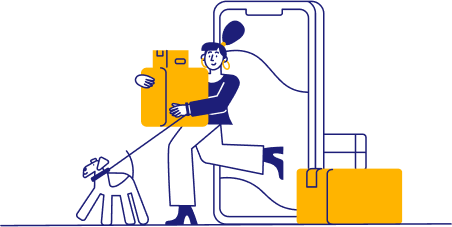
Go ahead and celebrate because if you’ve made it this far, you’re well on your way to that A+ resume! By spending more time throughout each phase of the writing process, you’re vaulting yourself closer to your next teaching job. It’ll be time to turn in a simple resignation letter at your current job and start setting up your new classroom before you know it!
If you’re not quite satisfied with your current resume, upload it to our resume checker for our AI-powered tips. If it’s time to start from scratch, use our free resume maker to work with our AI from the ground up. We can’t wait to see you land your next teaching role!




